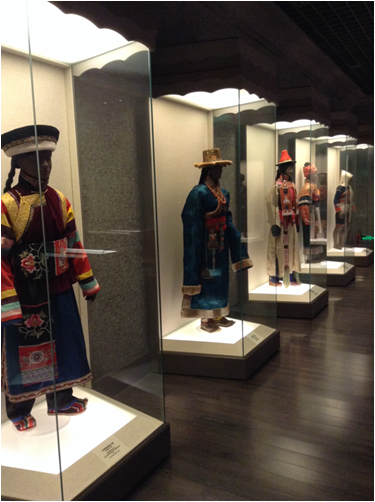
September 23, 2016, by Tony Hong
The Construction of a Chinese Majority Identity
By Jonathan McAllister,
SCCS Summer School Participant.
From the window of the teaching building at UNNC’s summer school program, the view is spliced by a collection of high-rise buildings: symbols of China’s modernity and surging economy, which grew by 6.7% in the first quarter of 2016. Nearer the university, a collection of construction workers’ huts squat on the urban landscape. These huts house migrant construction workers seeking to participate and benefit from China’s wealth creation and economic growth, having migrated from communities within China. These migrants, their huts dwarfed by the city’s buildings, are from China’s ethnic minorities living in other provinces. And, just as state sanctioned discourses impose identities on ethnic minorities and construct their representations for the ‘gaze’ of the majority Han identity, the high-rise buildings’ windows have these construction workers’ huts directly in their gaze.
China’s population is diverse, consisting of 56 distinct ethnic groups. This problematises notions of what it is to be ‘Chinese’, disrupting ideas of a homogenous whole. Yet, the state has constructed an overwhelming majority Chinese identity: the Han (minzu). Comprising 92% of the overall population, the Han are considered modern, moral and progressive; the Chinese government consists overwhelmingly of Han nationals and Han citizens hold positions of power. Under the Qing Dynasty, however, ‘the Han of Inner China were hardly homogenous’ (Jonathan Fenby 2008: 9). This majority identity is thus a modern construct of a homogenous national identity within the People’s Republic of China’s (PRC) state discourse.
The sense of belonging to a national identity is reinforced through the construction of ethnic minorities as the ‘Other’. In representing ethnic minorities in the arts, tourist industry and education system as different to the Han ‘Self’, the majority of the population is ostensibly homogenised internally within China and the world. Dru Gladney (1994) argues that China’s Han majority is ‘understood in opposition and contrast to minority cultures [which are] thought to be more vibrant and easily objectified [compared to] […] the amorphous, invented Han Chinese Self’ (112). Hence, through state sponsored programmes and the arts, the eroticisation and ‘primitive’ representations of ethnic minorities objectifies the non-Han identities; this reinforces the sense of a modern, homogenised Han identity within the Chinese population, unifying the majority under a single constructed identity.
This Othering is enhanced through ID cards, in which citizens are obliged to carry, that define ethnicity and thus imposes a sense of cultural identity on citizens. For the Han majority this is beneficial as it assimilates individuals into the majority ethnicity. Additionally, it creates a sense of cultural identity for ethnic minorities, unifying communities of nationalities not belonging to the Han majority. Nonetheless, such state imposed ethnic identification seeks to Other ethnic minorities by excluding them from the majority. In conjunction with exotic and ‘primitive’ representations in state discourses, this imposition encourages individuals to identify with their minority representations and cultural practices, reinforcing the Han sense of a modern Self and leading to inequality based on ethnicity.
Edward Said, in his acclaimed work Orientalism (1978), demonstrated how the notion of the Oriental Other was a European ideological construction. In this work he suggests ‘Orientalism is […] grasped as a set of constraints upon and limitations of thought [rather than] simply a positive doctrine’ (2003: 42). In China there is an ‘internal Orientalism’ (Gladney 1994) where the ethnic minorities have their Oriental identities imposed by the state. Said’s notion of constraint, enforced by the powerful Self, is salient in relation to the Uygur population of China. A Muslim population, the Uygur women wear headscarves and are no more erotic or sensual than the Han. Despite this, in a number of artistic representations, they are displayed as sensual and exotic against their will (Gladney 1994: 114). This Othering of their identity psychologically constrains the Uygur through suggesting they are primitive and less powerful or modernised than the Han. Hence, Han identity gains subjectivity and privilege through contrast with an ethnic minority that can be ostracised and psychologically constrained as a result.
Through this internal Othering, therefore, the PRC have unified the majority population under a homogenised state identity that did not exist under Qing rule. Though beneficial in constructing a unified state, there are clear problems, such as educational exclusion, internal xenophobia and both restrictive and reductive constructs of cultural identity. The PRC are attempting to mitigate these effects, for example through positive action in higher education. However, it remains to be seen if the PRC can, or are sincerely motivated to, unite the ethnic minorities with the Han majority in regards to economic prosperity and life chances, while still retaining minority ethnic identities.
References:
Fenby, J. (2008). Modern China: The Rise and Fall of a Great Power, 1850 to the Present. London: Penguin.
Gladney, D. (1994). ‘Nationality in China: Refiguring majority/minority/identities’. In The Journal of Asiatic Studies, Vol. 53, No. 1: 92-123.
Said, E. (2003). Orientalism. London: Penguin.
No comments yet, fill out a comment to be the first

Leave a Reply